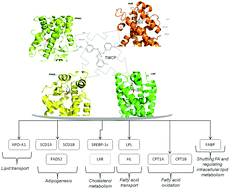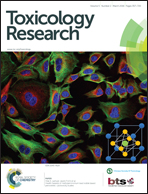Tri-m-cresyl phosphate and PPAR/LXR interactions in seabream hepatocytes: revealed by computational modeling (docking) and transcriptional regulation of signaling pathways†
Abstract
The interactions between tri-m-cresyl phosphate (TMCP; an organophosphate flame retardant) and peroxisome proliferator activated receptors (PPARs) or liver X receptor α (LXRα) were investigated in seabream hepatocytes. The study was designed to characterize the binding of TMCP to PPARα, PPARγ and LXRα by computational modeling (docking) and transcriptional regulation of signaling pathways. TMCP mainly established a non-polar interaction with each receptor. These findings reflect the hydrophobic nature of this binding site, with fish LXRα showing the highest binding efficiency. Further, we have investigated the ability of TMCP to activate PPAR and LXR controlled transcriptional processes involved in lipid/cholesterol metabolism. TMCP induced the expression of all the target genes measured. All target genes were up-regulated at all exposure doses, except for fatty acid binding protein 7 (FABP7) and carnitine palmitoyltransferase 1B. Collectively, our data indicate that TMCP can affect fatty acid synthesis/uptake and cholesterol metabolism through LXRα and PPARs, together with interactions between these transcription factors in seabream liver.


 Please wait while we load your content...
Please wait while we load your content...